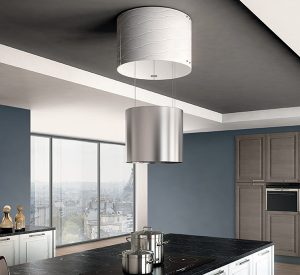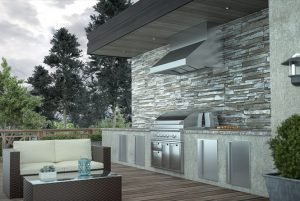It’s time to clear the air; when remodeling and designing your dream kitchen, proper ventilation may not be the first thing that comes to mind, but it should be. An efficient range hood plays a critical role in extracting smoke, grease, odors and other by-products of cooking, that escape into the air while using your range.
Today’s hood manufacturers have mastered the art of combining form with function, creating high-end, statement pieces that are powerful enough to handle the diverse cooking needs of an amateur home chef to that of the casual entertainer. Making the right decision on ventilation is easy, if you heed the following tips:
Understand Your CFM Needs
Ventilation efficiency is measured by how many cubic feet of air the hood removes per minute, i.e. CFM. No matter the hood’s look, design and appearance, it is important that its power closely match the range’s energy output/BTU’s. It’s recommended that you have 1 CFM per 100 BTU. The higher the heat output, the higher the CFM needed. Get it? Got It? Good!
Turn Down The Volume On The Hood’s Noise-Level
Let’s face it, your first introduction to range hoods was probably the 100 year-old vent/fan over your studio apartment or dorm’s small range. Noisy, but much quieter than the alternative fire alarm. A Sone is a measurement of loudness, as perceived by normal hearing levels. Measurement/ratings for hoods vary from as quiet as a soft whisper to as loud as traffic noise. Be sure you’re comfortable with the level and quality of noise emitted by your new hood.

Turn Up Design
These days, the types of range hood designs are almost limitless. From under the cabinet, to wall-mounted, to ceiling/island options, there are a plethora of colors, finishes, architecture and styles to fit any aesthetic.
Faber Range Hoods has more than 60 years’ experience in manufacturing the best, highest quality range hoods. With more than 30 models offering one of the largest selections of style, features and performance, Faber reigns king in the industry. Its Zoom hood is the nation’s first retractable range hood, lowering directly above the cooking area, and withdrawing back to make itself a part of the lighting fixture.
To Recirculate Or Not-To-Recirculate
If unable to be ducted to the outside environment, you’ll need a hood with a recirculating kit, which cleans air through a filter, than reintroduces it into the kitchen. Periodic changing/cleaning of the filter (suggested once every three months) will be an important part to maintaining the air quality of your cooking space.
Outdoor Grills & Cooking Spaces Need Hood Love Too
 Show your outdoor kitchen a little love; often overlooked, outdoor ventilation is super important for keeping cooking spaces safe.
Show your outdoor kitchen a little love; often overlooked, outdoor ventilation is super important for keeping cooking spaces safe.
Zephyr’s Cypress Outdoor Pro hood is the gold standard in outdoor ventilation. Made with a corrosion resistant, 304–grade stainless steel, the hood houses high-performance baffle filters that enhance airflow and are dishwasher safe. Three-speed metallic knob controls withstand extreme heat and moisture. The unit now has dual-level halogen lighting and an extended 32” depth for even more capture over a spacious grill.
Also, newer to the market, the HEAT Versa hood has the largest capture area of any hood in the industry, which means safer cooking conditions. Additional features include large commercial-style baffle filters and powerful 3-speed internal blowers delivering up to 1250 CFM. Its high-end stainless steel surface perfectly matches virtually every grill’s brushed finish.

